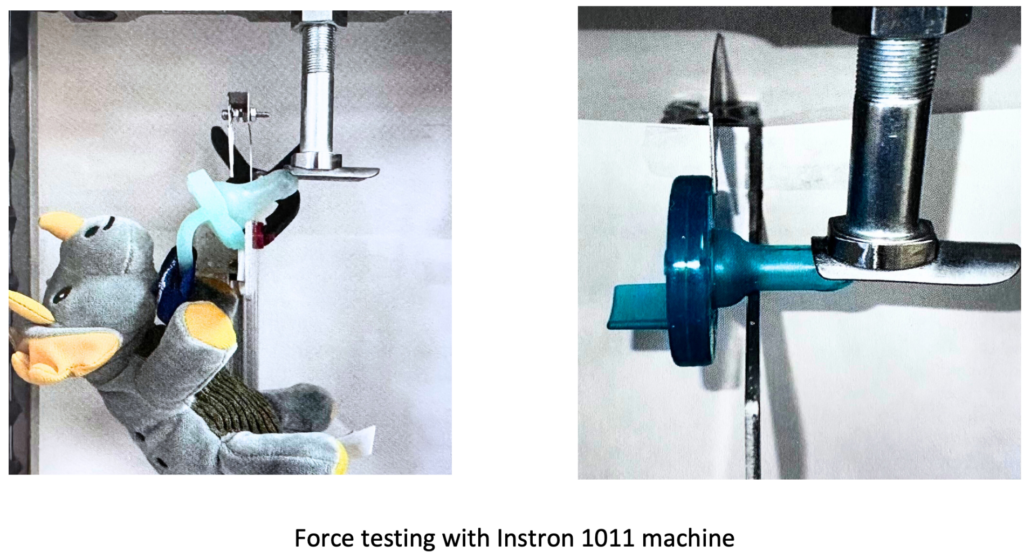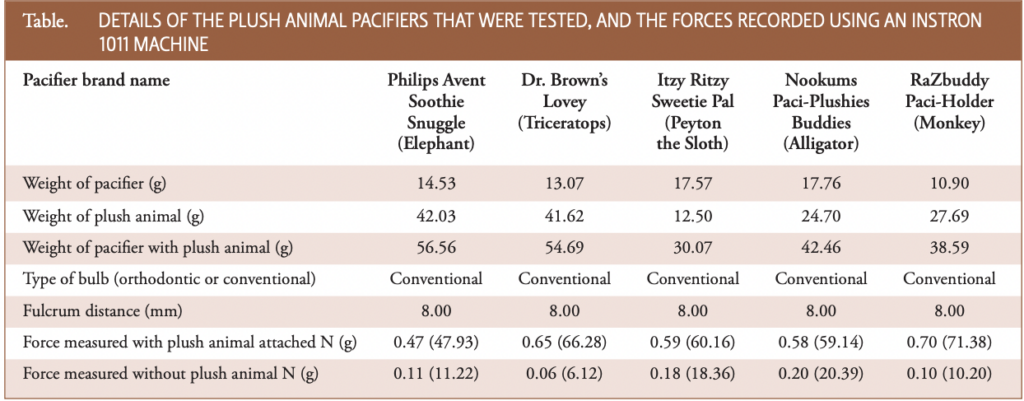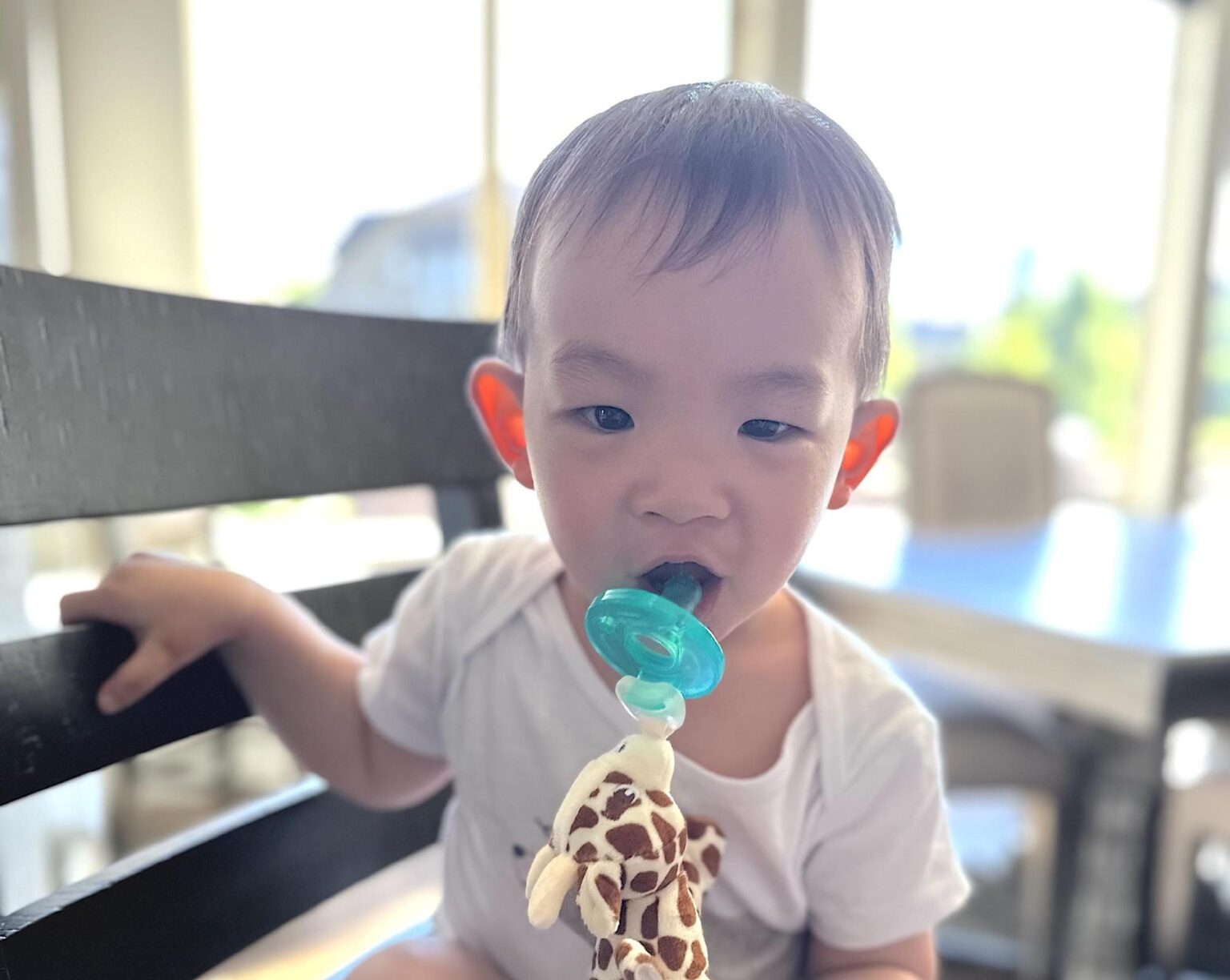Pacifiers can bring many advantages to your baby’s general well-being. In addition to providing a source of comfort and helping alleviate minor discomforts like teething pain, they offer a way for your baby to relax and self-regulate their emotions. In recent years, plush animal pacifiers have gained enormous popularity. They combine the benefits of a pacifier with a cuddly stuffed animal. In this article, we will explore a pilot study newly published in the Journal of Pediatric Dentistry that examines the forces generated during the use of plush animal pacifiers. Understanding the potential effects of these forces can help parents make informed decisions about the safety and suitability of these pacifiers for their infants.
The Study: The pilot study titled “Forces Generated During Plush Animal Pacifier Use” aimed to measure the forces exerted on infants’ mouths when using plush animal pacifiers. Five of the most popular brands of plush animal pacifiers were weighted with a digital laboratory balance. The pacifiers were then placed on an Instron mechanical testing machine that measured the force they generated in Newtons (N).

Findings of the Study: The study revealed several important results regarding the forces generated during the use of plush animal pacifiers:
- The force measurements from the five plush animal pacifiers ranged between 0.47N (47.9g) and 0.70N (71.4g), which exceeded the forces used in orthodontics to move teeth.
- The force generated by plush animal pacifiers has the potential to contribute to malocclusions and change normal craniofacial development.
- Product recommendations for plush animal pacifiers should be reviewed

Limitations of the Study:
- While we have extensive research on orthodontic forces and permanent teeth, there is limited information on the force necessary to move primary dentition.
- There is a great deal of variability in the design of the pacifiers and how plush animals are attached to them. The further away the plush toy is from the fulcrum, the greater force it can generate.
- The study was performed in controlled laboratory setting and has limited generalizability with regards to its clinical translation.

General Safety Considerations for Plush Animal Pacifiers: While the pilot study provides valuable insights, it is essential for parents to consider a few safety factors when using plush animal pacifiers:
- Age Appropriateness: Plush animal pacifiers are generally designed for infants up to a certain age. It is crucial to follow the manufacturers’ guidelines and choose a pacifier that is suitable for your child’s age and developmental stage.
- Regular Inspections: Regularly inspect the plush animal pacifier for any signs of wear and tear, loose parts, or damage. Replace the pacifier if it shows any signs of deterioration to ensure the safety of your child.
- Hygiene and Cleaning: Maintaining proper hygiene is crucial when using any pacifier. Clean the plush animal pacifier regularly according to the manufacturers’ instructions to prevent the buildup of harmful bacteria.
Frequently Asked Questions:
1. When can I introduce a plush animal pacifier to my baby?
Plush animal pacifiers are generally suitable for infants aged three months and older. However, consult with your pediatric dentist for personalized advice based on your child’s development.
2. Can plush animal pacifiers cause dental problems?
Plush animal pacifiers have added weight to them, which may contribute to adverse movement of teeth. Further studies are needed to determine their effect on teeth and palate development. Generally speaking, prolonged or incorrect pacifier use can contribute to dental issues.
3. How often should I clean the plush animal pacifier?
It is important to clean the plush animal pacifier regularly, following the manufacturers’ instructions. As a general rule, wash it with warm water and mild soap and rinse thoroughly after each use.
Conclusion
The pilot study on forces generated during plush animal pacifier use sheds light on the potential pressures exerted on infants’ mouths while using these pacifiers. While the study suggests that plush animal pacifiers can generate enough force to move teeth in a lab setting, further studies are needed to determine their effect on palate growth and teeth alignment. It is important for parents to prioritize safety, follow age-appropriate usage guidelines, regularly inspect and clean the pacifiers, and consult with healthcare professionals when in doubt. By making informed decisions, parents can provide their infants with comfort while ensuring their oral health and overall well-being.
Reference
Tesini DA, Berk DA, Harshini R. Parakh HR. Forces generated during plush animal pacifier use: A pilot study. Pediatr Dent 2023;45(3):177-80.
Why Should You Choose Union Pediatric Dentistry in Denver, Colorado?

We understand the importance of your child’s oral health and are committed to ensure their thriving smile is well cared for. Led by Dr. Mike, our board-certified pediatric dentist, our skilled and knowledgeable team is dedicated to safeguarding your child’s dental well-being and guiding you through their significant milestones. We recognize that every child is special and deserves tailored dental care that meets their unique requirements. As parents, you can rely on us to be there for you and your family at every stage of your child’s growth and development, promoting a healthy and radiant smile for years to come!





